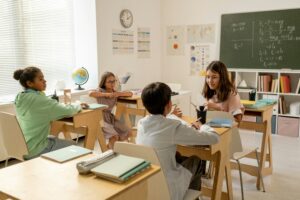Effective Teaching Strategies: Maximizing Learning Potential


Effective teaching is the cornerstone of successful education. It involves employing various techniques and approaches to engage students, facilitate learning, and foster academic growth. In today’s dynamic educational landscape, educators must adapt their strategies to meet the diverse needs of learners. This article explores some proven effective teaching strategies that can enhance the learning experience for students across different levels and subjects.
Creating a Positive Learning Environment
A positive learning environment is essential for effective teaching. Establishing a classroom atmosphere that is welcoming, inclusive, and conducive to learning can significantly impact students’ engagement and motivation. Teachers can achieve this by fostering positive relationships with students, promoting respect and empathy, and encouraging collaboration among peers. Additionally, maintaining a well-organized and visually stimulating classroom can help create a supportive learning environment where students feel valued and inspired to participate actively.
Differentiating Instruction
Every student has unique learning styles, strengths, and challenges. Differentiating instruction involves tailoring teaching methods and content to accommodate these individual differences, thereby maximizing learning opportunities for all students. Educators can differentiate instruction by varying the pace, complexity, and format of lessons, providing alternative assessments, and offering additional support or enrichment activities based on students’ needs. By adopting a differentiated approach, teachers can ensure that every student receives personalized instruction that meets them at their level.
Utilizing Active Learning Techniques
Active learning promotes student engagement and retention by encouraging learners to participate actively in the learning process. Instead of passively receiving information, students are involved in activities such as discussions, problem-solving, group work, and hands-on experiments. These interactive experiences not only deepen students’ understanding of the subject matter but also foster critical thinking, collaboration, and communication skills. Incorporating active learning techniques into lessons can make learning more meaningful and memorable for students, leading to improved academic performance.
Implementing Technology Integration
In today’s digital age, technology has become an integral part of education. Integrating technology into teaching can enhance instruction, facilitate personalized learning experiences, and prepare students for success in a technology-driven world. Teachers can use various educational technologies such as interactive whiteboards, multimedia presentations, educational apps, and online resources to supplement traditional teaching methods. By leveraging technology effectively, educators can create dynamic and interactive learning environments that cater to diverse learning styles and preferences.
Providing Constructive Feedback
Feedback is a vital component of the learning process as it helps students understand their strengths and areas for improvement. Effective feedback should be timely, specific, and constructive, focusing on students’ progress toward learning goals and providing actionable insights for improvement. Teachers can offer feedback through verbal communication, written comments, assessments, and peer evaluations. By providing regular feedback, educators can empower students to take ownership of their learning, set meaningful goals, and strive for continuous improvement.
Encouraging Student Collaboration and Peer Learning
Collaborative learning promotes social interaction, teamwork, and knowledge sharing among students. By working together on group projects, discussions, and problem-solving activities, students can learn from each other’s perspectives, skills, and experiences. Peer learning also fosters a sense of community and mutual support within the classroom, empowering students to take on leadership roles and contribute to each other’s knowledge. Teachers can facilitate student collaboration by assigning group tasks, promoting peer tutoring, and creating opportunities for cooperative learning experiences.
Fostering Critical Thinking and Inquiry
Critical thinking is a fundamental skill that enables students to analyze information, evaluate evidence, and make informed decisions. Inquiry-based learning encourages students to ask questions, explore topics independently, and seek solutions through research and experimentation. By engaging in inquiry-based activities, students develop curiosity, problem-solving abilities, and a deeper understanding of the subject matter. Teachers can foster critical thinking and inquiry by posing open-ended questions, encouraging curiosity, and providing opportunities for investigation and discovery.
Promoting Active Listening and Communication
Effective communication is essential for successful teaching and learning. Teachers must actively listen to students, demonstrate empathy, and create opportunities for meaningful dialogue. Encouraging students to express their thoughts, ask questions, and articulate their ideas fosters communication skills and self-expression. Additionally, incorporating activities such as debates, presentations, and storytelling can enhance students’ oral communication skills and confidence. By promoting active listening and communication, educators can create a supportive learning environment where students feel valued and empowered to share their voices.
Effective teaching is a dynamic process that requires dedication, creativity, and adaptability. By employing a combination of proven strategies such as creating a positive learning environment, differentiating instruction, utilizing active learning techniques, integrating technology, providing constructive feedback, encouraging collaboration, fostering critical thinking, and promoting communication skills, educators can maximize learning potential and empower students to succeed academically and beyond. As education continues to evolve, teachers must continue to explore innovative approaches and best practices to meet the diverse needs of learners and inspire a lifelong love of learning.





